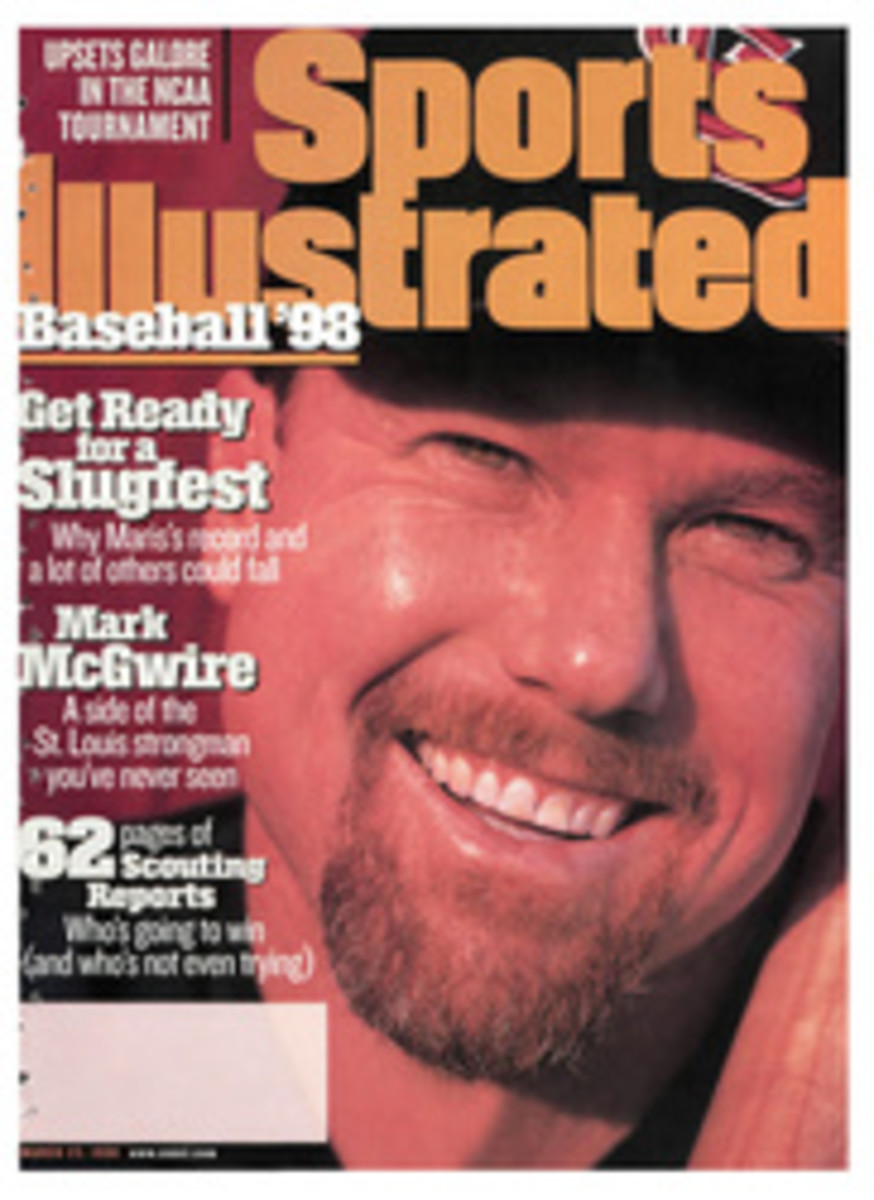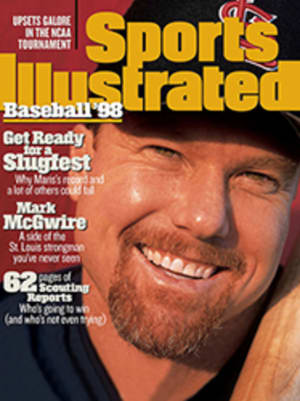
Anaheim Angels DOING WHATEVER IT TAKES TO BREAK EVEN
CLOSE BUT NO CIGARS/AL WEST
Ask Chuck Finley about the fluorescent lemon-yellow 'do he was
sporting during spring training, and he'll joke, "I lost a bet
with my parole officer." But ask the 35-year-old lefthander how
it feels being the senior statesman on a team that hasn't been
to the playoffs since his rookie year of 1986, and you can see
why Finley might feel as if he's been in jail.
While he's been well-compensated for his stretch in baseball
prison, Finley has at times felt hopeless. He's seen the Anaheim
front office go from a quick-fix plan (buying older, high-priced
veterans), to a wait-and-see approach with products of the farm
system, to the current combination of the two strategies.
"Our system was so depleted because we'd go out and get a Rick
Burleson and give away three minor league guys," Finley says.
"Those three-for-one deals for older players hurt us. But I'm
glad to be where I am right now. A couple of years ago, when
they got rid of everybody and started over with minor leaguers,
I thought, I don't know if I can wait to see if these guys can
play. But these guys have turned out to be pretty good."
Guys like outfielders Garret Anderson, Jim Edmonds and Tim
Salmon, shortstop Gary DiSarcina and first baseman Darin Erstad.
They're all homegrown and have all prospered under vice
president and general manager Bill Bavasi. His appointment in
January 1994 was a clear signal that the Angels were intent on
changing their expensive--and ultimately futile--fix-it-all-now
tactics of the '80s, which were rooted in a desire to win a
world championship for their aging owner.
The son of Buzzie Bavasi, a former G.M. of the Dodgers as well
as the Angels, Bill grew up believing passionately in the farm
system, thanks to his first job with the Angels--in 1980, as a
minor league administrator. "With the financial realities of the
'80s, the Angels could afford to put together a marquee team,"
Bavasi says. "It was a fun team to watch--and we made money. But
the dynamics have changed. Unless you're one of the haves, it's
necessary to develop your own talent, to create a kind of
stability."
Bavasi's plan fits well with Disney's company line: no foolish
spending. But Disney okayed an increase of $15 million over the
original $100 million budget for remodeling Edison International
Field, the ballpark formerly known as the Big A. And Bavasi was
given permission to exceed the salary budget of $40 million.
Erstad and righthander Ken Hill reaped immediate benefits.
Erstad signed a four-year, $7.25 million contract in February;
Hill got $16 million over three years in November. The one-year
free-agent signings of DH Cecil Fielder ($2.8 million, down from
$9.2 million last year) and 1993 Cy Young Award winner Jack
McDowell ($1.1 million, down from an asking price of $5 million)
illustrate that, at heart, Disney is still thrifty.
This provides a rare moment of corporate harmony, considering
that the Angels' front office believes money spent does not
necessarily translate into wins. "We have a base of players who
started with and were brought up in this organization," says
second-year manager Terry Collins. "We've got them under
contract for a few years, so we know we've got a nucleus that is
going to be here."
It's a young but veteran nucleus that's been on a three-year
roller coaster together. In '95 the Angels opened a shocking
11-game divisional lead, only to lose 31 of their final 49
games, before dropping a one-game playoff to the Mariners.
Despite high hopes for '96, Anaheim didn't recover from that
collapse, finishing 70-91, 19 1/2 games in back of the Rangers.
Last year the Angels were in first as late as Aug. 19, but
within a 10-day period their leadoff man, Tony Phillips, was
arrested for cocaine possession; Finley, in the midst of a
10-game winning streak, fell while backing up a play at the
plate and broke his throwing wrist; and catcher Todd Greene's
season ended when a foul tip broke his right wrist. Still, the
club finished only six games behind Seattle.
Finley and Greene should be healthy to start this year. And with
a Not-So-Big Daddy (Fielder dropped 35 pounds in the off-season)
hitting behind Salmon, Bavasi and Collins expect the Angels to
contend for the AL West title. "All an organization can do for a
player is give him an opportunity to compete," Fielder says.
--Paul Gutierrez
COLOR PHOTO: V.J. LOVERO UPHILL BATTLE A good year from the expensive, but erratic, Hill would help lift the Angels into the elite class. [Ken Hill pitching]
COLOR PHOTO: V.J. LOVERO [Phil Nevin]
BY THE NUMBERS
1997 Team Statistics (NL Rank)
1997 record: 84-78 (second in AL West)
BATTING AVERAGE .272(7) OPP. BATTING AVG. .269(7)
RUNS SCORED 829(5) ERA 4.52(5)
HOME RUNS 161(8) FIELDING PCT. .980(11)
OFF-SEASON MOVES
WHAT THEY NEEDED: Proven starters, a slugger at DH and a middle
infielder.
WHAT THEY GOT: Ex-Yankee Cecil Fielder is big and strong, but
don't big and strong guys usually hit more than the 13 home runs
he had last season? New pitchers Omar Olivares and William
VanLandigham provide as many questions as answers. Randy Velarde
and Phil Nevin shore up the infield.
WHAT IT ALL MEANS: If Fielder is more phat than fat, his bat
could juice up an already potent offense. But with Mark Langston
gone and Chuck Finley old and Ken Hill coming off a mediocre
year, this team is still probably two arms away from being a
contender. Makes you wonder why Disney wasn't willing to spend a
little money on a quality starter.
THE X-FACTOR
The last time Terry Collins and Phil Nevin hooked up, things got
ugly. In 1995, Collins, then managing the Astros, informed
Nevin, a rookie at the time, that he was being sent to Triple A.
Nevin flipped, tossing furniture. Days later he was traded to
Detroit. We hope Nevin doesn't flip when he reads this, but if
he starts more than 50 games in '98, the Angels are in trouble,
because he backs up the team's best players--outfielders Tim
Salmon and Garret Anderson, first baseman Darin Erstad and third
baseman Dave Hollins. Should any of those players miss
substantial time, the Halos won't win more than 85 games.
Projected Roster With 1997 Statistics
Manager: Terry Collins (second season with Anaheim)
BATTING ORDER B/T BA HRs RBIs SBs
1B Darin Erstad L .299 16 77 23
2B Randy Velarde* R .285 14 54 7
CF Jim Edmonds L .291 26 80 5
RF Tim Salmon R .296 33 129 9
DH Cecil Fielder[***] R .260 13 61 0
C Todd Greene R .290 9 24 2
3B Dave Hollins S/R .288 16 85 16
LF Garret Anderson L .303 8 92 10
SS Gary DiSarcina R .246 4 47 7
BENCH
IF Phil Nevin[***] R .235 9 35 0
OF Orlando Palmeiro L/R .216 0 8 2
IF Norberto Martin[***]R .300 2 27 1
C Matt Walbeck[***] S/R .277 3 10 3
STARTERS W L IPS BR ERA
LH Chuck Finley 13 6 6.6 1.35 4.23
RH Jack McDowell[***] 3 3 5.8 1.55 5.09
RH Jason Dickson 13 9 6.2 1.47 4.29
RH Ken Hill 9 12 6.1 1.54 4.55
LH Allen Watson 12 12 5.9 1.51 4.93
RELIEVERS W L S BR ERA
RH Troy Percival 5 5 27 1.27 3.46
RH Mike James 5 5 7 1.63 4.31
LH Mike Holtz 3 4 2 1.27 3.32
RH Rich DeLucia** 6 4 3 1.43 3.89
RH Pep Harris 5 4 0 1.53 3.62
RH William VanLandingham[***] 4 7 0 1.56 4.96
[***] New acquisition (R) Rookie B/T: Bats/throws
IPS: Innings pitched per start BR: Base runners per inning pitched
*1996 stats **Combined AL and NL stats

